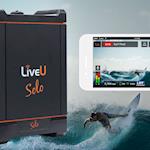If you write product reviews like me, once in a while, you get to do what I like to call the long haul review. That means, you actually get to take a great product like the AJA Ki Pro GO Recorder/Player, get it into your workflow and then test it out in a “real world” working environment.
I could not wait to try the AJA Ki Pro GO Recorder/Player to see what it could do and if it would live up to that solid as you know what AJA built reputation. Given that opportunity, that’s exactly what I set out to do.
What Is the AJA Ki Pro GO Recorder/Player?
As part of the successful AJA Ki Pro family, the AJA Ki Pro GO is a very portable option for all kinds of production. The AJA Ki Pro GO provides up to four channels of simultaneous HD/SD recording plus one backup to USB drives. That alone put the Ki Pro GO into my “buy it now” thoughts as a user and production friendly device.
At this point, who doesn’t have a ton of USB drives in their workspace? Having USB has made (for me) the Ki Pro GO a smart, affordable long-haul production choice.
Under that Hood
This rack-mountable unit's four 3G-SDI and four HDMI inputs record up to 1080p60 video. Image 4 The inputs are genlock-free, suiting them for use with a variety of cameras. Firmware update v1.5 offers timecode via SDI input with support for both time-of-day and timecode values. This update also improves overall stability, removes the 240-minute recording limit, and enables user-selectable primary and backup recording destinations. Also if you are connected over standard Gigabit ethernet, you can record directly to a Network Attached Storage (NAS), while recording locally, as well. Image 5

The Ki Pro GO can accept two channels of embedded audio per video input, and two balanced XLR analog audio inputs,(my personal favorite audio feature) mic/line/48v switchable. On the audio output side, the Ki Pro GO features two RCA connections for monitor out and a headphone jack located on the front of the unit.
My “Real World” Testing
Assigning, recording, and playback with the AJA Ki Pro GO was easier than I thought it was going to be. If I wanted to assign one source to all four inputs (which I did), I could do that too. But before I let you in on what I think are some deal making features, let’s look at some specs of the AJA Ki Pro GO. I was impressed. I think you will be too.
AJA Ki Pro GO Specifications
Video Format
- HDMI (8/10-Bit 4:4:4 RGB)
- 1080p: 60/59.94/50/30/29.97/25/24/23.98
- 1080i: 60/59.94/50
- 1080PsF: 30/29.97/25/24/23.98
- 720p: 60/59.94/50
- 576i: 50
- 480i: 59.94
- Video Signal Conversion
- HDMI to SDI
- 1080PsF: 30/29.97/25/24/23.98
- 1080i: 60/59.94/50
- Four HDMI inputs
- One HDMI monitoring output
- HDMI multi channel matrix monitoring
- Single-channel H.264 playback
- Selectable VBR recording settings
- Support for RP-188 timecode inputs on SDI with firmware v1.5
- Timecode values
- Time of day
- Balanced XLR analog audio inputs, mic/line/48V switchable
- 2-channel embedded audio per video input
- Easy-to-use Web UI, compatible with standard Web browsers
- Front-panel button controls with integrated HD resolution screen
- Stand-alone operation
Ki Pro GO In Action
There were many things I really liked about the AJA Ki Pro GO, but here are a few features that made a real believer out of me.
Call me old school, but the front-panel button controls with built-in HD screen were deal makers. I loved the fact that I could load up my drives and record, then “scrub” through the footage using the tactile controls. No digging for menus, and since I wasn’t in post, I could look at my footage right away without having to hook up yet another playback monitor.
Fast and convenient. I could look at it and then quickly get it to the next step in the workflow. If needed to, I could just pull out the drive and hand it off. Yes, I know there are other methodologies, but the whole time I had the AJA Ki Pro GO, I never lost or misplaced a thumb drive. That isn’t something I can say about a few SD cards that are still missing. There was a comfortable familiarity with the set up that made for an intuitive user experience.
Having the ability to “iso” record cameras allows for a higher production quality. Here is an example of what I mean—you need to set the same resolutions for each camera, which was fine for me since I am shooting one interview. Why would I want different resolutions?

Typically, if I am shooting an interview, but not for news, I want to be able to “iso” each camera. Host on Camera One (always), Guest on Camera Two, and my wide cover on Camera Three. I always have three camera ops too. Anyways, I can record each camera, then cut the edit pretty quickly, because I am not searching or overly trying to do a best “match up”
In the studio,control room, or even remotely I can use the AJA Ki Pro GO, either as a primary recorder or as a reliable back up. The set up and operation of the Ki Pro GO is also very straightforward.
There are a lot of production types that are also very happy with their AJA Ki Pro GO units.
Here are some of their thoughts:
“Recording each feed directly to USB media with Ki Pro GO is so convenient. We can quickly hand off the drives to our editors, who are mostly freelance and working off of a laptop, and they can get to work right away with high quality files in their NLE of choice, whether Adobe Premiere Pro or Apple Final Cut Pro. Within an hour we’re able to fold match replays or highlights into the stream. Being able to control and configure the device from a web-browser is also huge, and with the new 10-bit support in the latest firmware release, we can be confident that every time, we’re capturing high quality video with no risk of downtime.”— CineSys-Oceana Technical Specialist Javier Mendez
“Video gaming brings people together and often provides a much needed distraction from the real-world, and with Ki Pro GO we’re able to capture our tournaments and deliver high-quality video content to our global audience. It’s truly a reliable plug-and-play solution, so we never have to worry about technical issues, and we’ve received positive feedback from the entire production crew and editorial team.” — Black Stage Productions Founder Steve Suarez
“With all of the show’s smoke and pyrotechnics, we need a high-quality file or else the effects will break up when encoded, so H.264 is an ideal format for us. It provides the resolution we need in an extremely manageable file size. Ki Pro GO allows us to create an H.264 master of the whole show that we can easily upload to the cloud, so that the creative and design teams can review and quickly alter effects and integrate those changes ahead of the next tour stop.” — Video Engineer Jason Harvey
“Ki Pro GO has been a game changer for us in terms of ISO record capabilities and storage management. Normally with ProRes files, even LT, our show was 70-85gb a drive, and even transitioning to SSD’s for storage still took a while to dump. Being able to record video in H.264 and use those files in-house to view footage on the fly has been monumental for our workflow.” — Video Director Zac Leonard

Roll Credits
The AJA Ki Pro GO can be a part of a solid workflow solution in a lot of different production environments. That is one of the things that would make the Ki Pro GO such a logical choice for remote or studio work. When I had it, I used it almost every day because it was reliable and easy to use.













Comments
There are no comments on this blog post.